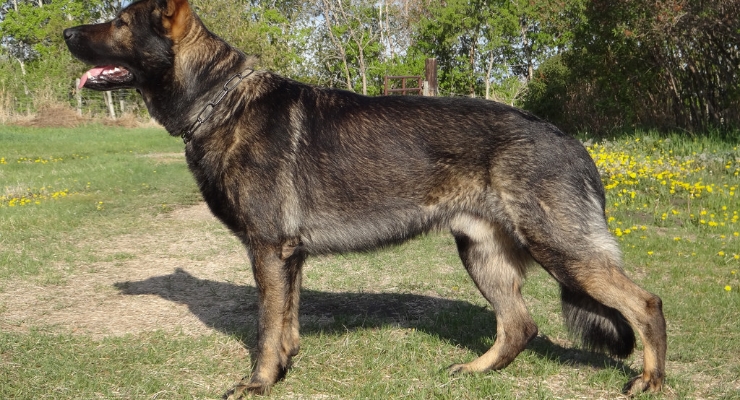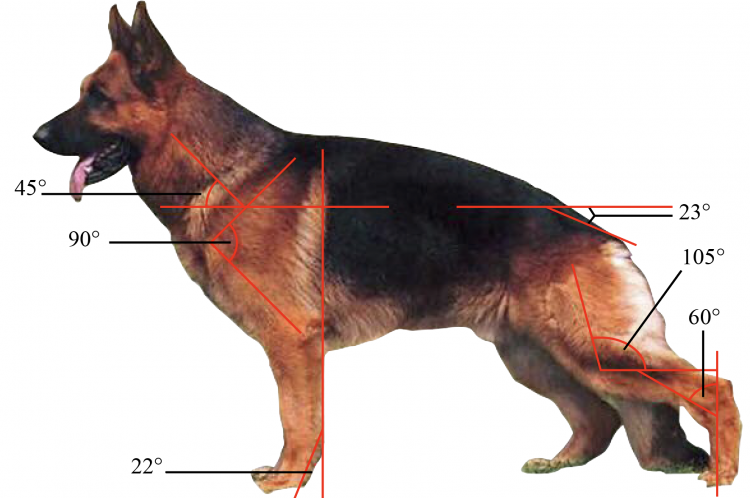
If you’ve seen any dog shows on TV, you may have noticed something odd about the German Shepherd Dog.
While your own GSD may not be a shining example of the breed, why does it seem as though the show dogs have such bent back legs?
Why Do the Back Legs of a German Shepherd Look Bent?
The simple answer is, of course, breeding.
The dogs in the ring are born and bred to show, and so their bloodlines, traits and history are supposed to be followed rigorously.
Many people who have show shepherds can trace their dog’s lineage back several generations and have a specific example in mind when breeding their dogs. Sometimes it gets taken too far.
The American Kennel Club (AKC) has regulations as to what is a breed standard and therefore competitive in the ring. The listing is fairly detailed, so we will just focus on the one portion that pertains to this article — the hindquarters.
According to the AKC’s German Shepherd Dog breed standards: “The whole assembly of the thigh, viewed from the side, is broad, with both upper and lower thigh well-muscled, forming as nearly as possible a right angle.”
So when you see German Shepherds on TV, they’ve been specifically bred so that their rear legs will come as close to that 90-degree angle as possible.

Health Problems
There are other reasons for German Shepherds to have bent legs, and the health problems listed below may be contributing factors.
1. Hip or Elbow Dysplasia
Hip dysplasia is a genetic disease. While the actual leg length may not be affected, the gait of the dog is changed because it is difficult for him or her to climb stairs or perform much physical activity.
Hip dysplasia affects the bones of the hips and hindquarters and has varying degrees of severity. Some German Shepherds have it but are not much affected by it, while others lose enough function in their “tail end” that they need to have a wheelchair.
Some warning signs of hip dysplasia include unwillingness to jump or stand on hind legs, not wanting to use stairs or steps, difficulty standing up or even seeming lame. This disease can present as early as 2 years old — so if you feel that something is not right, see your vet.
Elbow dysplasia can be another contributing factor. Elbow dysplasia is a complex condition caused by abnormal bone growth of the elbow.
2. Myasthenia Gravis
Myasthenia Gravis is another genetic disease/nerve disorder to which German Shepherds can be susceptible. While it does affect many places in the body, German Shepherds traditionally have hip weakness, and the hindquarters certainly are vulnerable to this disease.
One of the biggest signs of myasthenia gravis is the rapid depletion of energy. Your pup will get up and start moving about but tire quickly.
3. Arthritis
Arthritis could cause inflammation in the hind legs as well.
People get arthritis and so do pets, and just like in people the disease has varying degrees of impact on the body. Simple pain in the hips can cause your German Shepherd to change gait and walk lower, making the legs appear more bent.
Was YOUR Pet Food Recalled?
Check Now: Blue Buffalo • Science Diet • Purina • Wellness • 4health • Canine Carry Outs • Friskies • Taste of the Wild • See 200+ more brands…

Arthritis is very treatable by keeping your dog’s weight within normal levels and using pain medication if warranted.
German Shepherds generally have a history of hip and hindquarter weakness and are susceptible to diseases prevalent to those areas. It’s important to make regular trips to the veterinarian and keep your dog healthy so that excess weight does not put unnecessary stress on your dog’s rear end.
German Shepherds are highly resilient, wonderful dogs who can adapt to almost anything, so do remember that a diagnosis of disease is not often the tolling of the doom bell.
As always, a little dedication and a lot of love go a long way.
This pet health content was reviewed for accuracy by a veterinarian, Dr. Pippa Elliott, BVMS, MRCVS. It was last reviewed and updated Dec. 17, 2018.



